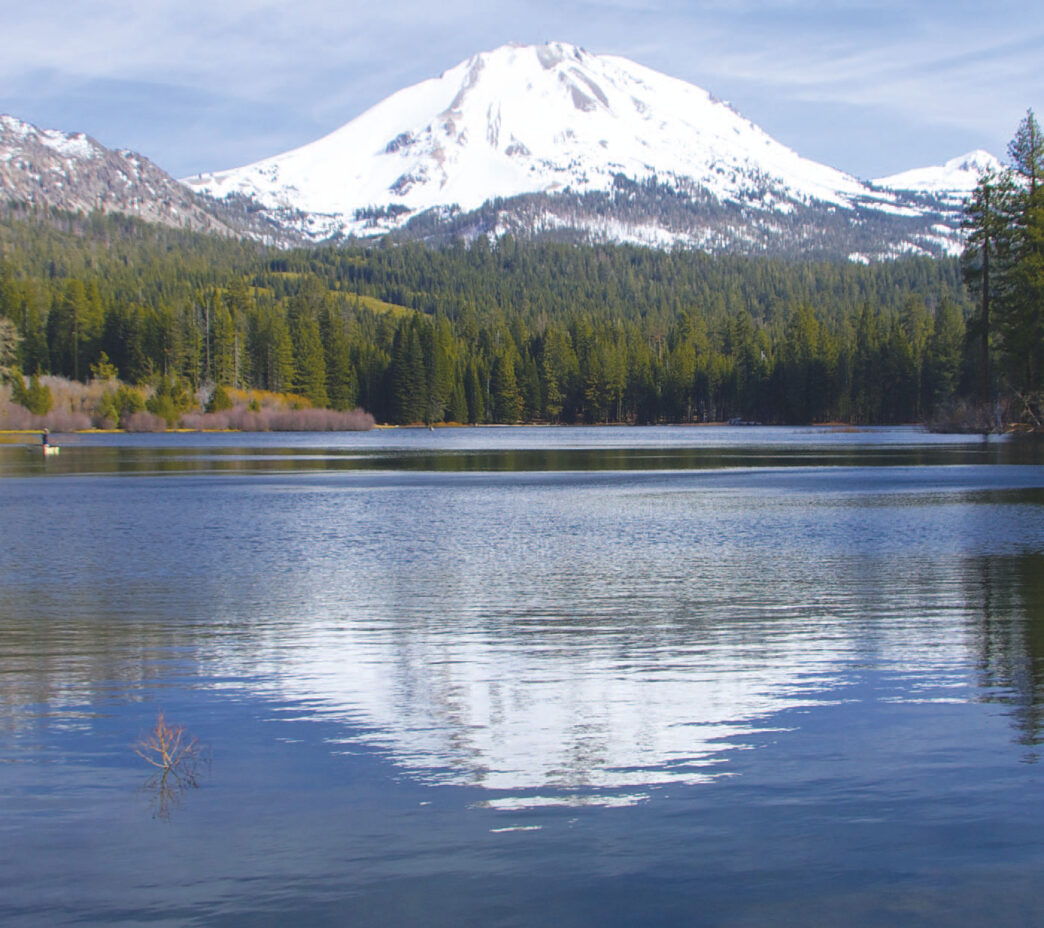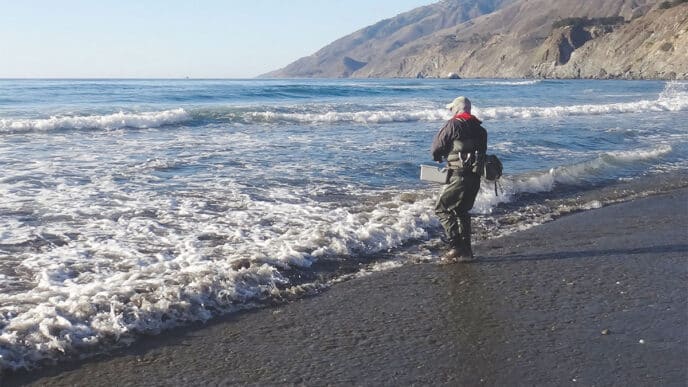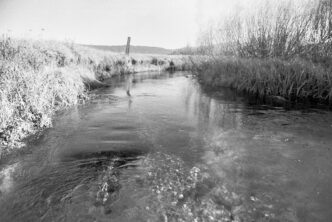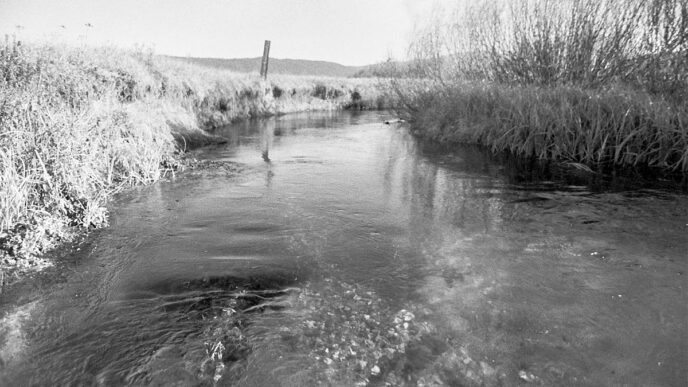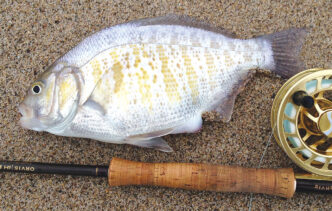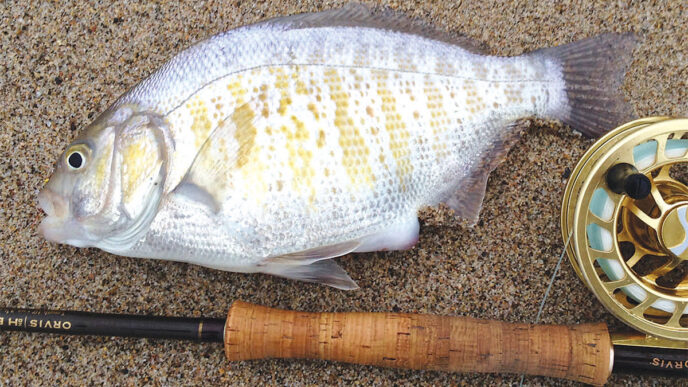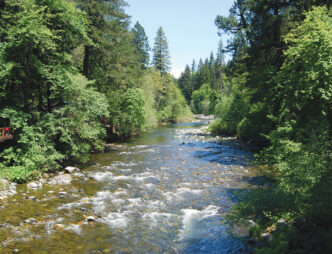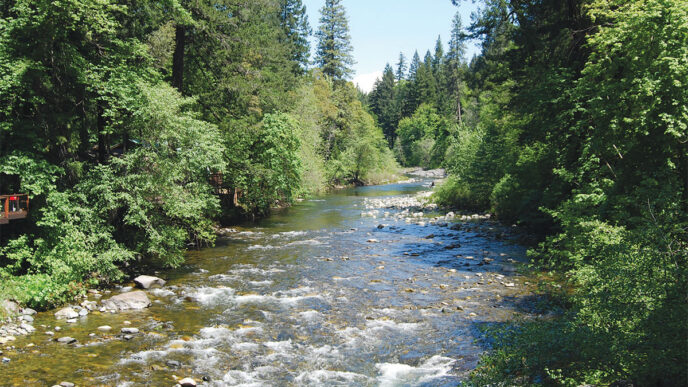Climbers are not the only ones who know what it’s like to get sucker punched by a mountain, or in this case, by an active volcano. It can also happen to anglers who fish Manzanita Lake, with Lassen Peak looking over your shoulder all day while you fish. I’m hardly alone in being knocked out by the beauty of that mountain, missing fish after fish, all day long.
That’s not why I head over to Lassen Volcanic National Park. Like any normal fly-fishing psychopath, I go to catch fish — big fish, and lots of them. They certainly are there. It’s not that the fish aren’t as appealing as the mountain, either. They are sturdy, wild rainbows and browns, some exceeding 20 inches. But the fish don’t seem, well, right there, the way the mountain is. Of course, there’s a much better chance I will pay attention if the fish are rising.
Manzanita Lake opens for fishing at ice-out, which, depending on the year, maybe anywhere from March through May. Since the lake sits at a frog’s hair shy of 6,000 feet elevation, it may turn on to good fishing somewhat later than other area lakes. A quick call to the park office at (530) 595-4480 can prevent a wild goose chase. Manzanita Lake is just inside of the Highway 44 entrance to Lassen Volcanic National Park, a touch over an hour east of Redding. When you turn off of 44 into the park, you will see Manzanita off to the right, adjacent to the guard shack. Pay the day-use fee and drive over to the boat-launch area, where there is also parking and an outhouse.
There are often other anglers in the vicinity who may be good for a little insider information on what’s hatching and which flies are working. There may even be a few conventional-tackle anglers around, but if so, they are in a vast minority. Park regulations call for artificials only (no bait), single barbless hooks, and catch-and-release angling. A 9-foot 5-weight fly rod is ideal, but slightly heavier and lighter equipment will also serve.
Manzanita Creek enters the lake below and to the right of the launch area. Warning signs spell out exactly how far you need to keep from the mouth of the creek, which is important to the fishery. Since rainbows are spring spawners, and spring comes late at that elevation, the angling-free zone is meant to protect fish still in a weakened condition. Every year, anglers get ticketed for fishing inside the boundary, which the fish seem to know very well. Respecting the rules will not only help protect the fishery, but will help you avoid a fairly expensive ticket. Ignore all those rising fish inside the boundary.
Wild-Trout Proclivities
Once upon a time, Manzanita Lake was stocked with hatchery trout, but not since about 1980. Today, all the fish are wild and seemingly robust. It’s commonly said that there are no small fish in Manzanita, and on some sweet days, you could swear that was true. Average fish range from 13 to 16 inches, with plenty of larger fish to break tippets and inspire some fairly creative vocabulary choices, which often echo across the water. In the spring, the fish tend to be somewhat less selective, but assuming they are ever pushovers is abject folly. Some fly fishers claim these fish are way smarter than the average angler.
Like most lake fish, these are cruisers. Trout in lakes often feed in a somewhat regular pattern, as if they’re working the same circuit over and over again, and being able to predict where a fish is going to be is an advantage. This, of course, is less true in the deeper body of the lake and more so along the shallower shorelines. When the light is right, you can even see a fish and anticipate where it’s heading. A well-placed nymph, emerger, dun, or spinner is at least going to get a hopeful, though maybe cynical look-see. These fish may have seen more flies in their lifetime than you have. Still, they seem always hopeful for food. When they shun whatever you have on the end of your line, it probably is not because they aren’t hungry. Think of these fish as well-educated and naturally critical, but not impossible.
Major Hatches
The spring season is all about midges, mainly nymphs under indicators, but also twitched back beneath the surface. At times, you may even see adult midges skimming the surface of the water or small rafts of adults buzzing around in syncopated disorder. The key to knowing where to start is what you see or don’t see.
Midges come from the shallower portions of the lake, but may drift into deeper water with wind and waves. Watch for rising fish along the lake’s edges. If there is a breeze, a good bet is to concentrate on the shore toward which the breeze is blowing. Manzanita has plenty of bushes growing out of the shallower areas, and these are also places that might well collect windblown insects.
If you see rising fish, the trout are likely taking individual emergers, adults, or clusters of midges. Prepare for making a good presentation by lengthening your leader to at least 12 feet, including a 3-to4-foot 6X tippet. Try to make your casts as delicate as possible, because the fish are close to the surface. A dose of powdered desiccant every few casts will keep your surface offering floating high and dry. Several tried-and-true midge dries include Quigley’s Spider Midge, Midge Hanger, and Skittering Midge in sizes 16 to 20. The classic midge cluster pattern is the size 14 to 16 Griffith’s Gnat.
How long should you leave your midge imitation on or in the water before making another cast? That’s one of those “What’s the meaning of life?” questions. In other words, no one knows for sure. If everything looks right, that is, if the fly is a reasonable imitation of what you see on the water, if it’s in an area where you have seen fish working, and if nothing like wind or waves is upsetting your presentation, leave it as long as you can stand it. If that’s only a minute or 10 minutes, who is to say you’re doing it wrong? I’ve left flies out longer than 10 minutes, and suddenly I’d get a grab. Remember that in still water, the fish are cruising around looking for food. If there are no rising fish, go with a midge nymph or two under an indicator. Use as small an indictor as you can see well and can cast with reasonable ease. I seldom fish midge nymphs deeper than about three feet below an indicator, because, as I said, midges come from the shallow areas of the lake. Good patterns to try include the Beaded Zebra Midge, Chan’s CB Frostbite, and Gold Bead Brassies in 16 to 20.
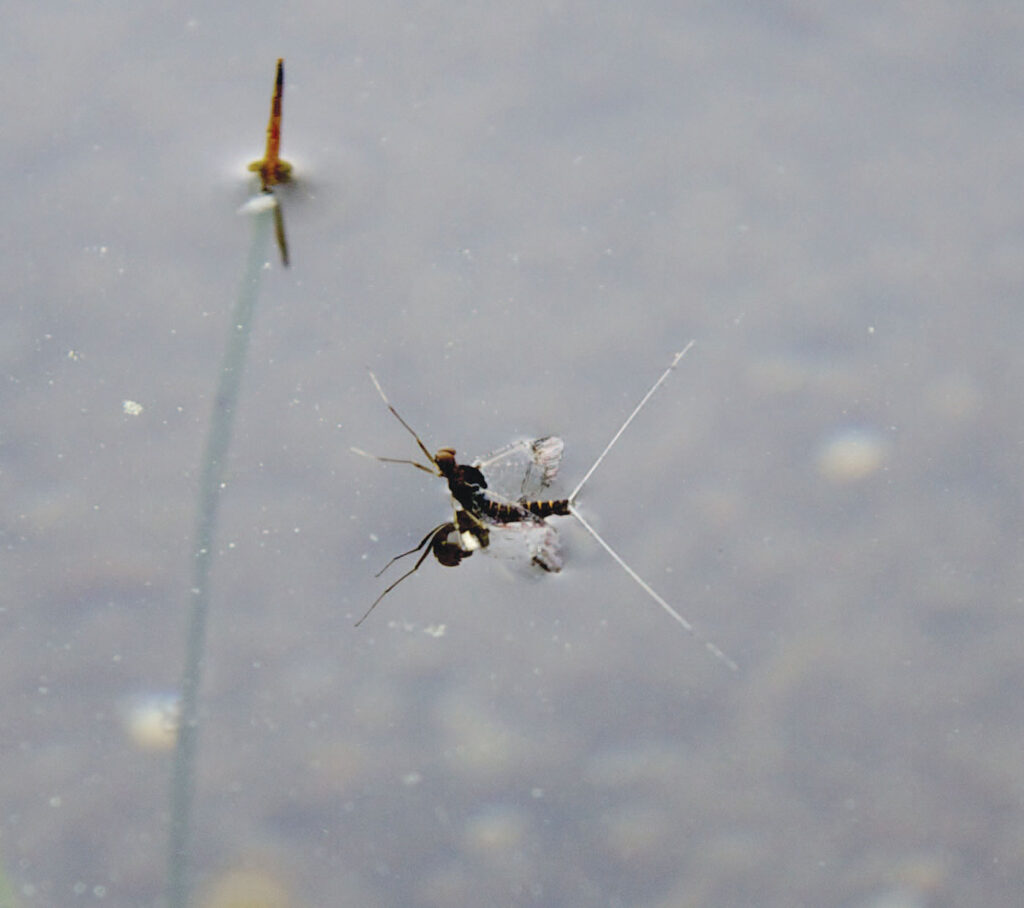
There are days when the trout want to take their food on the move. Cut back your tippet to at least 4X (I like fluorocarbon for this) and tie your fly or flies on with a Nonslip Mono Loop Knot for maximum strength and action. Toss your fly out, let it sink a moment or two, and begin stripping it back in. Strikes on a moving fly can be violent, so be ready.
June usually triggers a transition from midges to Callibaetis mayflies as the dominant food source. This is the premier summer hatch on Manzanita, and having nymphs, emergers, dries, and spinners on hand will prepare you for whatever quirks the fish may exhibit on any given day.
Many days begin with no fish rising, which means you should start with Callibaetis nymphs under indicators. Though it may not seem terribly strategic, simply positioning yourself somewhere in the middle of the lake often works well. Any of a host of general attractor nymphs will catch fish, including Bird’s Nests, A.P. Nymphs, and Gold-Ribbed Hare’s Ears. Try these in size 12 early in the season, but as the summer wears on, the nymphs get smaller, and sizes 14 to 16 will produce better. I strongly prefer beadhead nymphs, because they sink faster and eliminate the need for split shot. This may not seem like exciting fishing, watching a strike indicator for hours, but it often outproduces any other method of fishing.
By the afternoon, a subtle change comes over the lake, and breezes usually kick in, most often from the west. This orients fish toward the shorelines and exposed bushes, which catch and collect a windblown feast of emerging mayflies. This is much more engaging fishing, but it also requires more skill than needed when indicator nymphing.
Watch for rising fish and see if there are bubbles left behind after each rise. A rise without a bubble left behind is a clue that the fish are taking emergers just under the surface. Good emergers include the D&D Cripple, Harrop’s Last Chance Cripple, Quigley Cripple, and Mercer’s Poxyback Cripple. Again, early season insects run larger, so start with size 12. As the summer progresses, think more in terms of size 14 to 16.
If there is a bubble left on the water after a rise, the fish are definitively taking bugs off the surface, either duns or spinners. Choosing between the two can be tricky, but at least you always have a 50 percent chance of choosing the right one. Rises to duns tend to be more aggressive, as if the fish knows the bug may fly away at any moment. Rises to spinners are more leisurely, as if the fish knows it has all the time in the world. Duns are a little easier to fish, because with their upright wings they are more visible on the surface of the water. Good Callibaetis dun patterns include Paraduns, Comparaduns (some folks call these Haystacks) or even a good old Adams. Start with size 12 early season and drop down in size as the summer progresses. A Rusty Spinner in the appropriate size will work if the fish want spinners.
If you visit Manzanita in late June or early July and don’t mind fishing late in the day, the lake features a sometimes outstanding Capering Sedge hatch (some anglers call it the “motorboat” caddis). These large, ungainly caddisflies skitter across the surface just before and after dark. Be sure to cut back your leader to at least 4X and cast out a large, buoyant caddis dry fly such as a size 10 Goddard Caddis. If the wind is blowing, you can cast across it and let the wind straighten your line and drag your fly across the surface. If the evening is still, cast your fly out and slowly strip it back while making it look like a tiny water-skier. The fish will often hook themselves.
Another little-known phenomenon during summer afternoons at Manzanita is the ant hatch. When the wind starts blowing through the trees, it knocks big black ants into the water. These seem invisible to anglers. If you spot rises in the middle of the lake and don’t see anything floating on the water, ants are a good bet. Adult damselflies are another wind-tossed morsel popular with Manzanita trout.
This sequence of hatches stays more or less the same until the end of Manzanita’s season at the end of October. When all else fails, subsurface techniques such as stripping leech patterns, damselfly nymphs, or Woolly Buggers with an intermediate fly line will often save the day.
Manzanita is small enough to fish entirely in one day if you work at it. There is no part of this lake that does not contain fish. It’s ideal for float tubes, pontoon boats, prams, canoes, and kayaks. No motors are allowed.
Quirky History
Scientists verify that Manzanita Lake has been around for hundreds of years, but perhaps not in quite the same form. Today, the untrained eye might never notice the old levee that was built in the early 1900s across the original outflow to the lake. This expanded the size of the lake and rerouted the outflow of Manzanita Creek. In the late 1800s, there was an Atsugewi Native American man whom the white settlers called “Shavehead” and who, for a time, was one of the most wanted desperados in early California. Late in his life, he lived on the south shore of Manzanita Lake. He claimed that when he “discovered” the lake, there were no fish in it. He said that he personally introduced trout from Hat Creek into the lake some time before 1900. Where the brown trout in the lake came from has been lost to history.
Lassen Peak, still a technically active volcano, last erupted from 1914 to 1917. By that time, the levee was already installed and at least some fish were already calling the lake home. One has to wonder about the effect on the fishery of a massive volcano so close by belching volcanic ash into the atmosphere for years. Apparently the recuperative powers of nature are extraordinary.
Another Local Option
While Manzanita Lake is not typically crowded, I have arrived to find it looking like a bowl of Cheerios for all the float tubes. It may just happen that some large fly-fishing group is having a fish-out on the day you arrive. If so, and you don’t feel like fighting the crowds, Lake McCumber can also save the day.
Head back toward Shingletown on Highway 44 about 12 miles and turn north on Lake McCumber Road. Veer left on Ritts Mill Road to find the boat launch ramp. McCumber isn’t as scenic as Manzanita, and there are some hatchery rainbows tossed in with the wild, naturally spawning fish, but there are also some big rainbows and browns to be had. Some anglers love McCumber for the fact that its fish seem just a tad less picky than Manzanita’s, and you won’t have a gorgeous volcano to stare at and miss fish.
The hatches, equipment, flies, and strategies are darned near the same for McCumber as they are for Manzanita. It may not have the same grandeur, but it has plenty of fish. You can even keep five fish, if you are so inclined.
Apparently I’ve made peace with getting sucker-punched by Lassen Peak. Even on days when the fishing turns out to be especially challenging, fishing in the presence of this stunningly beautiful volcano is likely to send your worries and everyday stresses right up in smoke.




